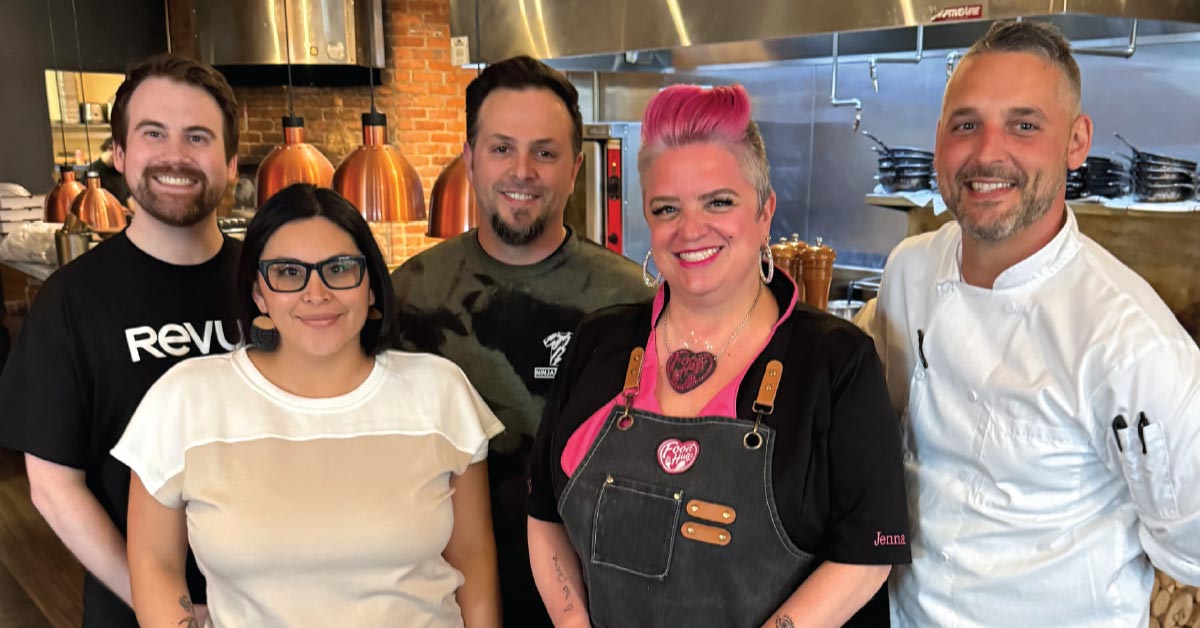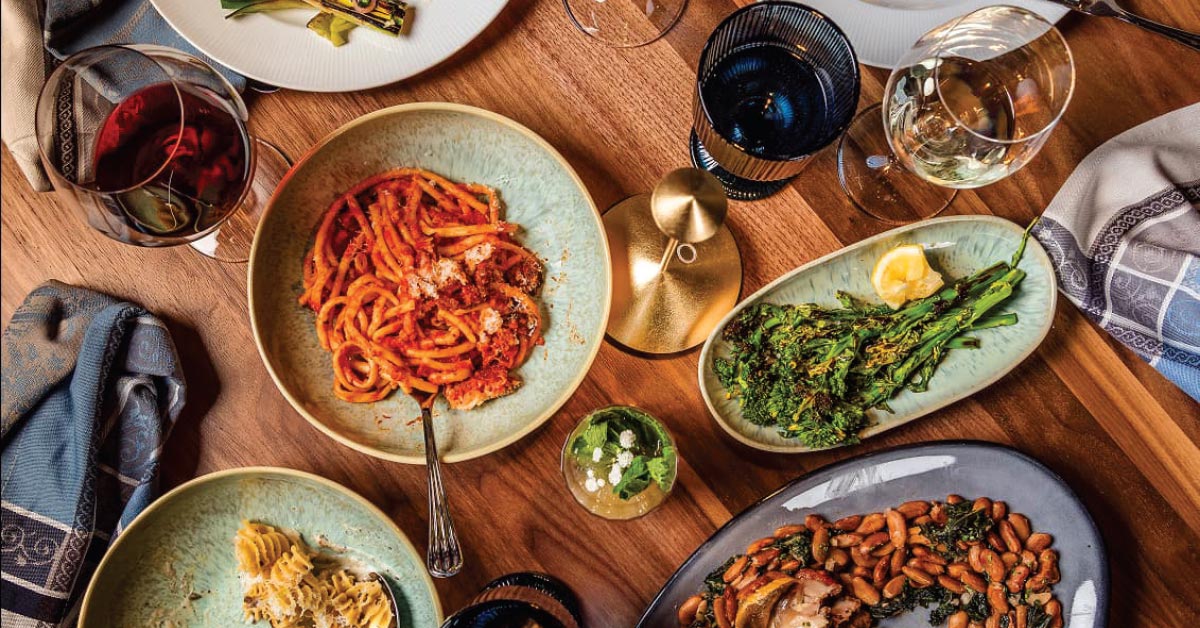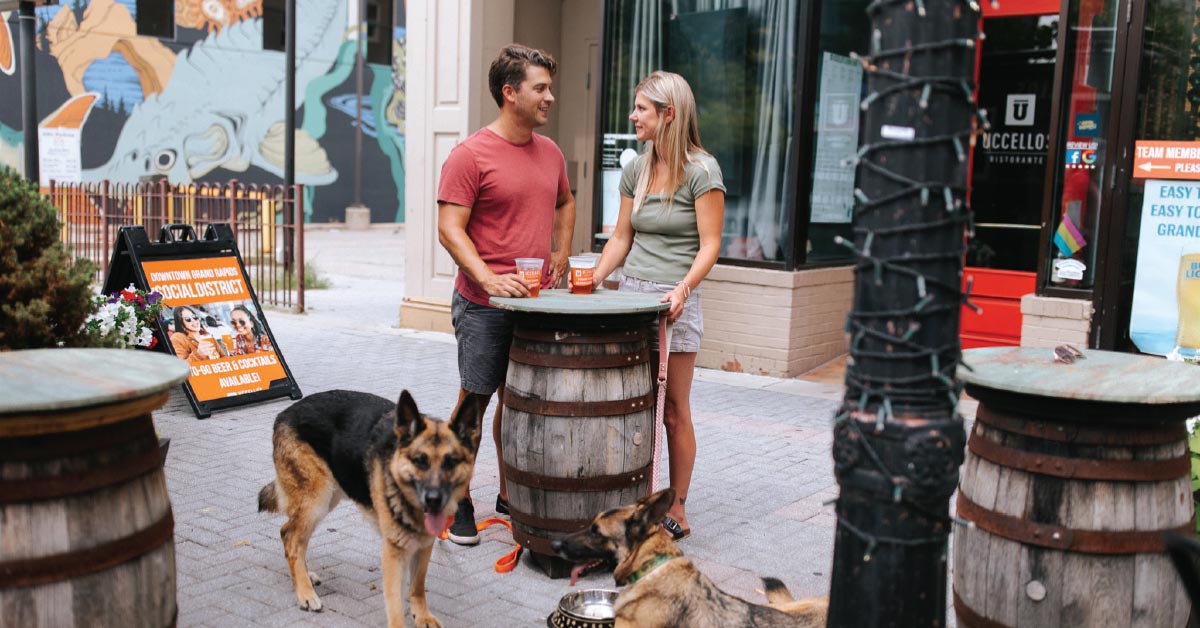Local restaurants are struggling, to say the least.
If you’ve seen your grocery bills skyrocket in recent times, just imagine theirs—and then add on payroll, equipment, rent, utilities, certifications, licenses, furniture, tableware, and on and on.
Of course, these expenses have always existed for eateries, but inflation and supply chain issues paired with a population that increasingly chooses to stay in over going out means hard times. The beginning of 2025 saw a slew of beloved eateries shutter, while others, like Amore, took to social media to ask for support.
That’s why we decided to have a roundtable with just a few of the many amazing local restaurant owners in West Michigan, talking about the challenges they’re facing, what they’re doing to survive and thrive, and why it’s all worth it. Here’s just a portion of our illuminating conversation, held at Terra.
PARTICIPANTS:
Paola Mendivil, Co-Owner, El Granjero
Rick Muschiana, Co-Owner, The Sovengard
Jenna Arcidiacono, Owner, Amore Trattoria Italiana
Clark Frain, Director of Operations, Terra
What are the biggest challenges you all are facing right now?
JENNA: The thing that used to be our issue was staffing. Now, that’s not an issue, because there’s no jobs, so we are keeping all of our staff. The problem is getting people off of their couches, off their cell phones and into the doors. It’s also hard because of the supply chain—we had to raise our prices. Plus, the new law that came into effect has made it so a lot of us need to find extra money somewhere for the PTO. If you’ve seen seven or eight restaurants close within a week, it’s because they were looking ahead and saying, “We don’t even have that in our account.” As much as they kept telling us it was going to happen, restaurants weren’t ready fiscally for an extra 40 grand.
So, what do you do? Do you add it to your menu prices? I’ve seen people put a fee on the bottom of their checks that’s 4%, and they say it’s a so-and-so fee. That pisses people off. No matter what we do, it’s going to piss people off, but they need to realize that we are purchasing food, cooking the food, prepping the food, serving the food, cleaning up. But it’s a luxury to for many people to go out, and we understand that.
I made a big post a few months ago when Rockwell Republic closed and four or five other places closed, and we had a really slow night. And I said, “Hey, tonight we had 19 people in here. I employ 14. So, four more than our employees were here tonight. What’s going on?” The comments on that were super interesting. I also talked about how it affects the local economy in other ways, where our food reps aren’t making money if we’re not buying food from them, and it’s a whole cycle. I think that opened people’s eyes, and they’re like, “Oh, we better go out.”
RICK: It’s funny, when you posted that, we had a similar, really bad night. There seems to be this ebb and flow with the way that customers are choosing to go out and when they come in, and it’s really hard to crack that code and be ready for it.
JENNA: And to staff for it. You don’t know what to do.
RICK: Yeah, you have full-timers there five days a week, and you end up with a day where you’re upside down on sales versus payroll. But you need them, because you know you’re gonna get busy on Friday and Saturday. But yeah, I definitely felt your pain.
PAOLA: It’s been hard because during the pandemic, we saw a lot of restaurants struggle as well, and so many close permanently at that point. And in the Latino community, what we saw was that families, to continue having income, started selling food from home. At the beginning, I was excited. But it’s been five years now, and they continue to do that. So now, that’s not our only competition, and they don’t have that overhead expense. It’s up to them whether or not they decide to structure and become a business, and start getting those critical steps and support from like, the Health Department.
RICK: Yeah, and all that has a cost to it. Every single thing that you have to do, to be certified by the Health Department, by the city, by the MLCC to serve alcohol, that all has a fee stamped to it. Plus, just the equipment, processes and procedures alone to start a commercial kitchen, even a small one.
Do you find that the fees are being applied consistently?
JENNA: No, everyone’s doing it different. And we don’t want it to be confusing for our guests. We want to be honest about it, but they also have to be understanding, and that’s where the issue may be.
RICK: I think there can be a sentiment where people are kind of directing the anger and the frustration towards the restaurant. Like, “Oh, they’re already making all of this money.” But I think --
GROUP: [LAUGHTER]
RICK: Exactly. There’s no perspective on what it is really like on the other side of the fence for small, independent business owners. Nobody’s making a million bucks. If you make 5% margins as a restaurant, you’re doing pretty good.
We’ve heard quite a few people complain about rising costs.
JENNA: Well, because their salary hasn’t gone up, but prices have. They’re getting the same amount of money per week, and then when grocery prices go up every couple months, they’re realizing they can’t make ends meet. Since I have a nonprofit [Food Hugs], I am getting so many requests to help with food right now.
PAOLA: The consumer behavior right now, you just don’t know how long it’s gonna be, so you’re kind of cutting all expenses. So, we see customers like, “No, I’ll pass.” Or from the restaurants, we see “$10 dinner specials.” At the end of the day, your bill is not gonna be $10, but that’s maybe attractive just to get people in the door.
JENNA: Or they’re just going to fast food, but when I look at fast food bills, it’s not cheap anymore. And the quality of the food that we are serving is homemade, with fewer preservatives and less of fake everything. I would love to be able to express that. You can come to us, where we make everything from scratch, we peel the potatoes, we cut the onions—or you can go somewhere the onions have been sitting frozen. If you’re going to choose one or the other, local is going to be better for your body, and the dollar difference isn’t that much.
CLARK: But using local ingredients is more expensive. If you wanted to get a case of something from a big distributor, or use the local farm, in most cases, you’re going to pay more with the local farmer. For the quality.
RICK: And it’s well-documented how local money stays circulated within the economy, versus corporate. Our mutual friend, Chris Andrus, co-owner of The Mitten, had a really poignant post a couple weeks ago. He felt like this was brewing for five years or more. Part of it is COVID, part of it is social, definitely political, definitely economical. It almost feels like this perfect storm that’s all colliding right now, and that really leads to shaky consumer confidence. Even if you’re in that middle income bracket, you’re probably looking at what’s happening, and what’s the first thing to go? It’s usually the affordable luxuries of coffee, going out to eat, things like that.
JENNA: Yeah, exactly. We’ve turned into a place that is for celebrations, right? Birthday, anniversary, graduations. But can that hold?
CLARK: It’s great for the weekends, but what about Tuesday?
JENNA: Right! And we can’t dumb ourselves down either, because those deals she mentioned, that means we’re making less than we were really supposed to be making. So, we can’t do a two-for-one. As much as West Michigan loves a coupon, we don’t have the luxury of being able to be cheaper.
CLARK: I feel like there’s an oversaturation of what we’re doing in this small town. I mean, Grand Rapids is a “big city” if you’re talking about Kentwood, Wyoming and the outside areas, but the breweries got oversaturated, then they started having a lot of problems, and with cannabis too, it’s like, holy cow, there’s one in my neighborhood now?
JENNA: But here’s the thing, when you’re smoking weed or have a gummy, don’t you get hungry?
CLARK: Well, they do DoorDash.
JENNA: Speaking of, things like third-party delivery aren’t worth it for us as a restaurant either. We don’t even do it.
RICK: Same here.
CLARK: We got on third-party. We had to.
JENNA: You did? It’s so expensive.
CLARK: Well, what you pay for a Margherita Pizza on third-party is not what you’re going to pay for the Margherita Pizza when you come in. We adjust our prices for the margin markup. I don’t want to. We do woodfire pizza—I mean, our pizza is great when it’s in front of you. Our pizza is not awesome 20 minutes later when you get home.
Uh, yes it is.
CLARK: [LAUGHTER] Well, I appreciate that. But how are we going to compete with what people are doing on Tuesday night, without the third-party? Whatever happened through COVID, people are like, “This is too convenient. I can sit and have it brought right to me.”
RICK: There’s definitely something that’s changed in how often people want to socialize. Social media and our phones and all that has made it very easy just to get that “fake social interaction,” I’ll call it. I’ll be so bold as to say, that’s not real. That’s something that I’m passionate about, and I think everybody else here is. There’s been a lot written by people smarter than me on what is the effect of having awesome restaurants and coffee shops, these gathering places in our neighborhoods, and what is the effect when they go away?
I think it’s a mark of an interesting society, an advanced society, that we have these places to hang out and gather and socialize, and food and drink has always been a huge part of that, for hundreds of years now.
JENNA: It’s scientifically proven that your serotonin levels will go up and you will feel better if you socialize. So, we have to remind people, you’re gonna have fun and you’re gonna feel good, and you’re gonna have time with friends and memories.
What have you all tried that’s worked, if anything?
JENNA: Social media posts, they help a lot. Like, if I have a tiramisu and I post it, it will get people in. Even if they’re just coming in for the tiramisu, they’re coming in, and usually they have more. To have a good social media person is going to be money for you. And people are doing specials, like at Quarantino’s across the street, he does a pasta/pizza/salad feature that’s 30 bucks for three things. But it’s hard to cut pricing right now, when we’re trying to pay our staff and keep going.
RICK: I think for us, as someone who really values the creative process and bringing that to the plate—as does everybody around this table—I found it exceedingly difficult to balance the desire to have forward-thinking, fun cuisine, trying new, funky things, with the realities of everything that we’re talking about here. Our concept at Sovengard has always been something that’s a little outside of the norm. I mean, I always think of my wife’s cousin who told me one time, “Yeah, we don’t come very much because it’s kind of weird food.” And I was like, that perfectly sums up what I think 50% of people in West Michigan feel.
JENNA: West Michigan, we’re still 50% not okay with weird.
CLARK: I wish people cared more about why we change our menu so often and where we get our ingredients from, but.
JENNA: I think that’s 5% of West Michigan. They’re into it, like, “Which farm is this from? Where did you get your --” And the rest couldn’t care less.
RICK: So, with our spring menu, we’re kind of just trying to read the room and pull it down a little bit. And that has nothing to do with sacrificing quality ingredients. But instead of maybe doing duck, we’ll do chicken instead. It’s cheaper, and maybe we don’t need to be pushing so much on “fancy” stuff, right now. If that allows people to come in that one extra day a week because they can afford it a little bit more, then we can read the room for a bit and see where we’re at in society.
PAOLA: But now I’m wondering, what other resources, like, what can other people and groups do? What can they bring together for the restaurants?
JENNA: Yeah, it’s their turn to give back to us. We’ve been giving back to the community for many, many years. It’s their turn to see the struggle and give back to us.
PAOLA: And also, the elephant in the room, we have a lot of undocumented workforce, and that’s been the challenge for so many years. Your employees become family, but with everything that’s happening politically, families separated, deportation, that’s going to disappear our workforce, for many of the Latino restaurants.
On those hard days, which is many of them, what keeps you going?
JENNA: For me, usually every shift there’s something amazing that happens, and sometimes it’s something not amazing that happens. Like, since we’ve been open 15 years, I’ve had regulars pass away. So I started this Memorial Bar, and I’ll make a plaque in honor of whoever passed, and then the person will come sit and have a drink with their loved ones. And that’s just become a recent thing, because I’ve had so much loss with regulars, but also I get to do cool stuff with Food Hugs every day. So, that’s kind of where I love that Amore was the baseline for it, but then I get to do good as well. So, every day, we’re giving people Food Hugs, which is what brings me joy. But I made that for myself so we could have that happiness.
CLARK: I still have the passion for the energy of what we do on our services. Like, it’s still really fun. I’m not so much the quarterback anymore. I’m more mentoring, which I’m getting a ton of fulfillment out of that. It’s like, “Hey, I got this idea, can I bounce it off to you?” Yeah, and then try it with that, and let me know what you think, and they’re like, “Yeah!” That’s energizing, being able to continually develop people.
PAOLA: I think just being part of the community, making a place to belong. Because when I came to Grand Rapids, I was like, “What is this place? I used to have 17 million neighbors in Mexico City.” So, it had to be a way of just getting to know people. And like you said, we’ve been in business for a long time, we get to see people who were dating when we just opened, who now have their families and bring their kids, and it becomes part of your family. I get the energy from the customers, from our community, and obviously our employees. Some of them have been with us for 18 years.
RICK: I think for me, it’s two things. One, I feel like as a community, a region, a nation, I feel like we still have so much work to do with our food sourcing, the way it’s grown, how we receive it, how we treat it and respect it. And Sovengard has always been about that and continues to be about that. And I also feel like feeding people has always been sacred to me. And I think you guys all probably feel the same way, there’s just something about that. It’s essential. Eating is an essential part of the human existence. And that someone would come into your place and choose to do that with you, I think that can never get lost in the shuffle.





